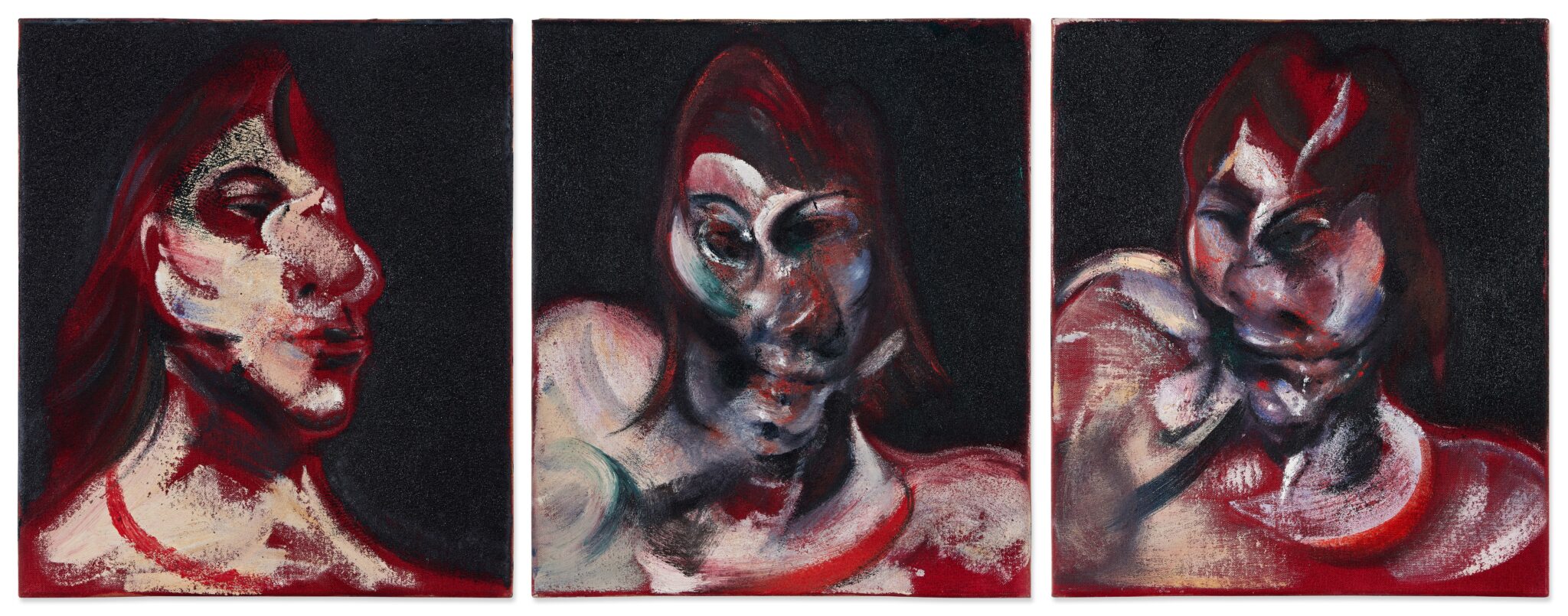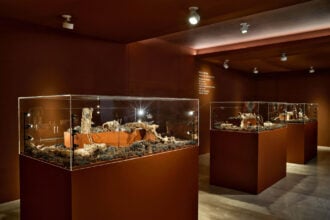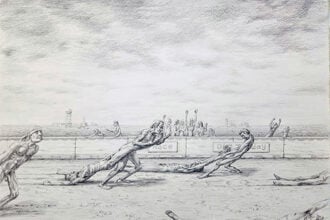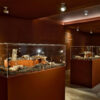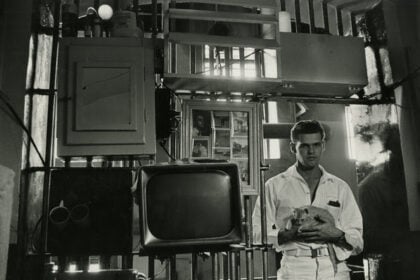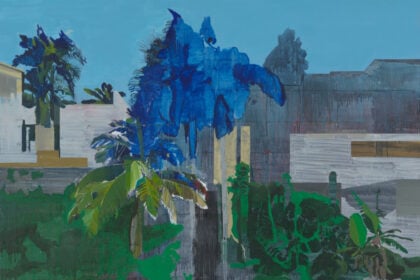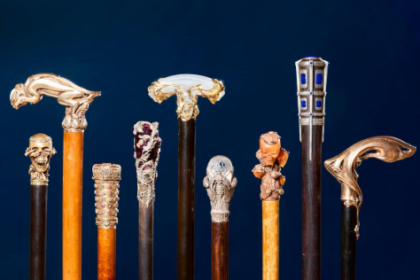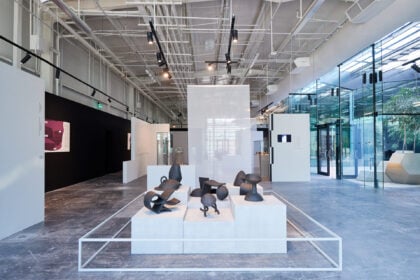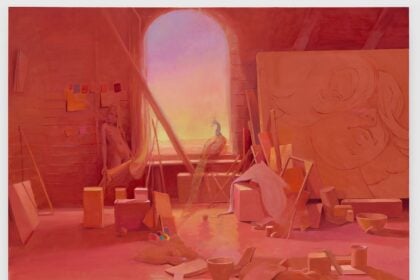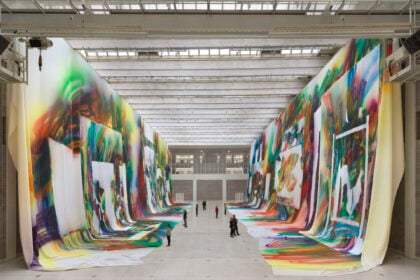NEW YORK, 14 SEPTEMBER 2022 – The name William S. Paley (1901-1990) will be forever intertwined with that of two of the great institutions born in the 20th century: Columbia Broadcasting System, Inc (CBS), which he transformed from a small radio network in the 1920s to a giant of American broadcasting, and MoMA – the first museum dedicated to Modern Art (founded in 1929) which he championed for half a century. In these dual roles, he was at the forefront of shaping American culture and taste – firstly behind the lens of CBS at a time when television emerged as the greatest new instrument of influence on the nation, and later at The Museum of Modern Art, Paley was the looking glass through which America saw itself at every momentous turn.
At the time Paley began collecting, an appreciation for modern art was a relatively rare, radical and forward-thinking thing. In the 1930s, few collectors had the courage and vision to collect the canvases of artists such as Picasso, Renoir and Matisse. Just as Paley had done on the frontier of broadcasting – when he had written the rules and broken the rules – the painters in his collection pioneered new modes of expression. Paley’s intuitive appreciation for early 20th-century works quickly established him as one of the foremost collectors of Modern Art in America, his instinctive and discerning eye informing the creation of a uniquely distinguished collection. At the same time, he also was an active force in advising and inspiring MoMA’s collection-building over five decades and donating to the museum a number of the greatest works in its collection, including Picasso’s Boy Leading a Horse (1905-06) and The Architect’s Table (1912), Cézanne’s L’Estaque (1882-83), and Redon’s Vase of Flowers (c. 1912-14).
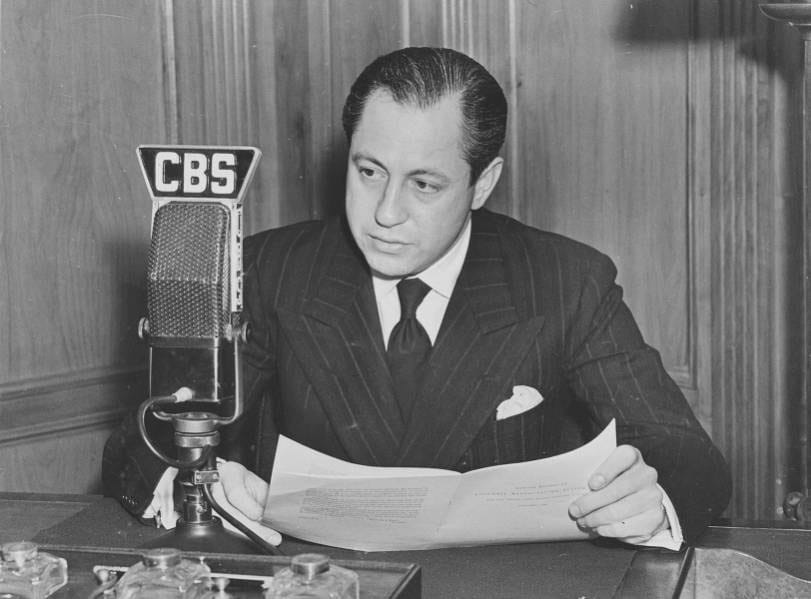
This fall, some 29 works acquired by William S. Paley over the course of his 40-year collecting career will come to auction for the first time in at least half a century. Consigned by the William S. Paley Foundation, their sale will support a number of charitable organizations close to William S. Paley’s heart, including The Paley Museum, the Greenpark Foundation (which owns and operates Paley Park) and, not least, a new endowment at The Museum of Modern Art, established by the Paley Foundation to support MoMA’s ambitious goals in digital media and technology and to provide for new acquisitions.
First in the sequence of offerings is an extraordinary work by Francis Bacon, arguably the finest of the artist’s small-format triptychs, set to lead the Frieze Week auctions in London this October. The work will be on public view in New York from 24 – 28 September, and in London from 8 – 13 October. This will be followed in November with a further offering across Sotheby’s Marquee sales in New York, encompassing some of the most radical breakthroughs in modern painting, from synthetic cubism to color field painting and crowned by one of the most important Cubist works by Picasso to appear on the market. Highlights from the collection will be exhibited in Hong Kong, London, Los Angeles and New York this fall.
“I remember how my father loved the great artworks he collected, and which were an important part of my own experience growing up. It’s deeply satisfying that the Foundation is able to use this group of works from his collection to further support MoMA, to which he was so dedicated.”
William C. Paley, Vice President of the William S. Paley Foundation
“It is a testament to the visionary philanthropy of William S. Paley that the bequest he made through his Foundation anticipated that, over time, the needs of the Museum would evolve in ways that could not have been foreseen or even imagined thirty years ago. We are deeply grateful to the Foundation for its support of the Museum and its commitment to Mr. Paley’s vision.”
Glenn D. Lowry, the David Rockefeller Director of The Museum of Modern Art
“I know how deeply my friend Bill Paley cared about The Museum of Modern Art and with what devotion he dedicated himself to its advancement. With this initiative, the Foundation will honor his intention and continue his vision for MoMA.”
Henry Kissinger, Chairman of the William S. Paley Foundation
“While many collectors shape their collections around that of the great museums, William S. Paley forged his own path, assisting MoMA in assembling its great collection and thereby influencing the appreciation of modern art across America. It is an absolute privilege to be working with them and with the Paley Foundation to help realize their fittingly ambitious goals. William S. Paley’s visionary collecting and unflagging ambition helped make MoMA what it is today – a catalyst for experimentation, learning, and creativity, a gathering place for all, and a home for artists and their ideas. We are thrilled to be associated with this exciting next step in its evolution.”
Brooke Lampley, Chairman and Worldwide Head of Sales, Fine Art Division, Sotheby’s
“The collection of William S. Paley is among the greatest historic American collections: in his collecting, and in his contributions to MoMA, Paley helped to redefine the face of Modern Art. That a single collector could have the daring to acquire the very best examples of such profoundly radical artists from Picasso to Bacon speaks to Paley’s visionary taste and relentless pursuit of the avant-garde. Paley’s acquisitions in the 1960s capture the groundbreaking artistic spirit of the post-war era – from Francis Bacon’s astonishing “Three Studies for Portrait of Henrietta Moraes”, which marks one of the greatest triumphs of the artist’s career, to canonical examples of post-war American color field painting by Morris Louis, Kenneth Noland, and Josef Albers.”
David Galperin, Sotheby’s Head of Contemporary Art, Americas
“Art’s unique power to communicate underpinned William S. Paley’s passion for collecting. He created an extraordinary private world, with works intimate in both format and character, scaled for personal enjoyment and contemplation. These consummate examples by pioneers of Modernism, from Renoir to Bonnard to Picasso, reflect the bold innovative thinking that always characterized Paley’s ambitions. Acquired between the 1930s and 1960s, his treasures are now to be offered on the market for the first time in over half a century.”
Simon Shaw, Vice Chairman, Global Fine Arts, Sotheby’s
INSIDE THE COLLECTION OF WILLIAM S. PALEY
“Don’t buy it unless you can’t live without it.”
William S. Paley
Francis Bacon, Three Studies for Portrait of Henrietta Moraes, 1963
Oil on canvas, estimate in excess of £30 million
London: Contemporary Evening Sale, 14 October
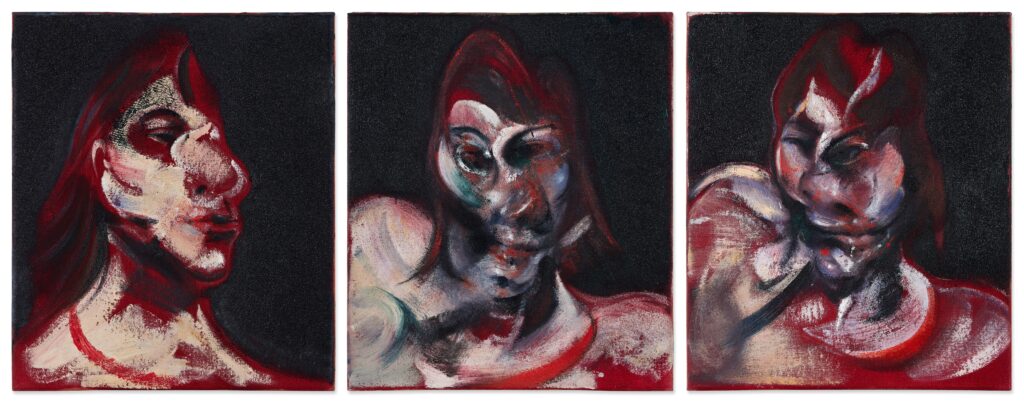
The triptych format was one that spoke directly to Bacon. Rooted in a religious past that taunted him throughout his life, while at the same time allowing for an evolution of form that tallied directly with his creative process (“I see images in series”, he said) it was a format that, in his hands, took on new life, fast becoming the signature motif that came to characterize his most powerful works. And of all the small-format triptychs Bacon created, this exceptional portrait of his Henrietta Moraes is arguably the finest, with Martin Harrison, editor of the Francis Bacon Catalogue Raisonné, eulogizing: ““The restricted palette of mainly crimson and white on a textural black ground is masterly, as are the energy and motion of the brushstrokes and smearing of the wet pigment. Indeed, Bacon’s execution has a power, skill and confidence that he scarcely ever surpassed in this format.”
Moraes typified Bacon’s ideal female friend – sexually uninhibited, unconventional, spirited if vulnerable, gregarious and a serious drinker. He first met Henrietta, ‘the queen of Soho’s artistic life’ and notorious bonne vivante, in the early 1960s, both frequenting London’s most fashionable haunts – she recalled: “When I was eighteen, I had spent almost all my mornings, afternoons and evenings with him…dined alone with him at Wheeler’s, oysters and Chablis, gone with him to the Gargoyle, listened to the wit and wisdom which flowed almost continuously from his lips” and it was at The French House where, over a glass of Champagne, the artist first said to Moraes, “I’m thinking of doing some paintings of my friends.”
Though male subjects – friends, lovers and fellow artists – feature large in Bacon’s work, Henrietta recurs with a fervent frequency that reflects his fascination with her. She is not only represented in a number of named portraits but is also the anonymous subject of many of his most powerful nudes. She captivated him, both physically – her sumptuous forms undulating across his canvases – and spiritually, a female mirror to his own untamed, bohemian character.
Soon after meeting Henrietta, Bacon commissioned feted photographer John Deakin to take a now renowned series of portraits of her, which became the artist’s primary source material as he started to paint her obsessively. Whilst photographs taken in a London pub regularly frequented by the three friends were utilized as an aide-memoire for this painting, at the same time, this exceptional work was also partially painted from life – possibly marking the last occasion on which Bacon painted from a live model. Speaking about the present work, critic John Russell describes: “This is the most … that can be said in painting at this time about human beauty.”
This painting, coming now to the market for the first time since Paley acquired it from Malborough Gallery in 1963, just a few months after it was painted, is not only among the finest triptychs in Bacon’s oeuvre, it also represents only the second instance of Bacon’s use of the 14 by 12 inch format that is so beloved – for its intimacy and intensity – by collectors and scholars alike.
Pablo Picasso, Guitare sur une table, 1919
Oil on canvas, Estimate $20,000,000-30,000,000
New York: Modern Art Evening Sale, 14 November
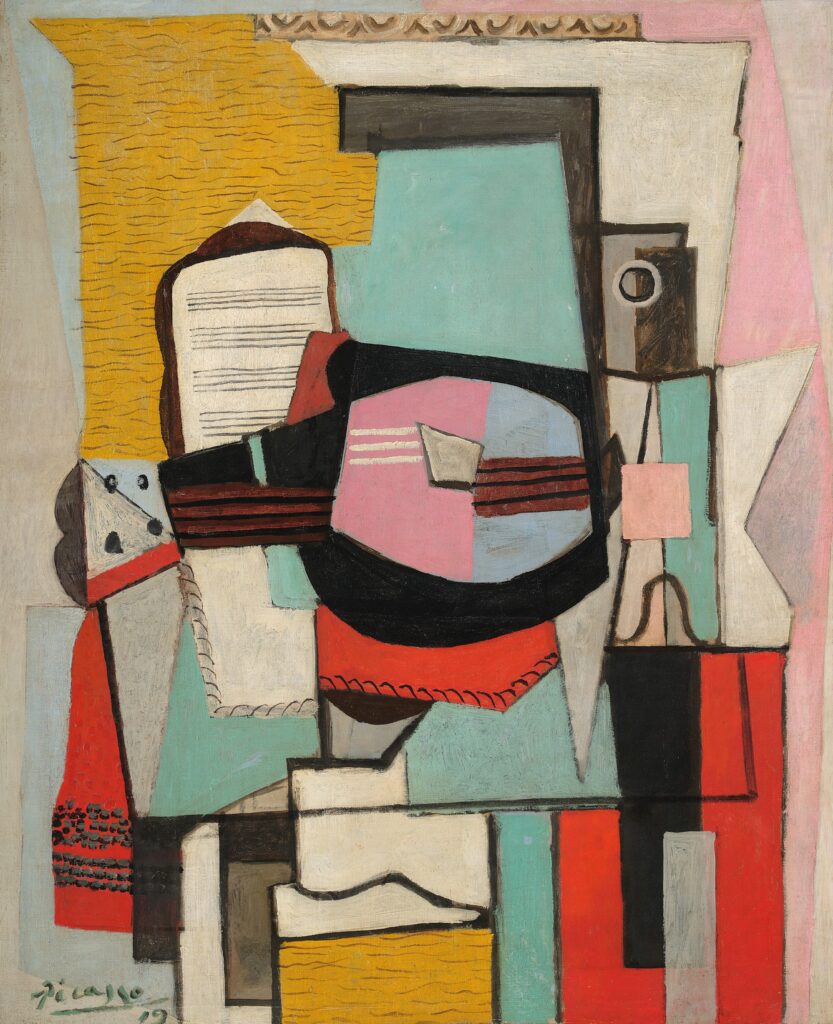
Cubism is considered to be Pablo Picasso’s most important contribution to Modern art – underpinning the artist’s entire creative output but also marking a defining shift for all that came after it. The single-minded focus on the dissection and representation of a three-dimensional form in an inherently two-dimensional medium forever transformed the tapestry of Modern art. It is testament to Paley’s overriding taste for modern art at its most imaginative and radical, that a work from this period of Picasso’s oeuvre is at the heart of his collection – hanging in his bedroom for many decades, since it was acquired in 1946.
Whilst major paintings from other key periods by Picasso are a mainstay of the auction world, his Cubist paintings are among the scarcest to appear on the market, since virtually all the significant works of this period are in international museums and institutions – a further indication of Paley’s natural leanings towards works of museum quality. This is the first time in five years that a work of this caliber has been offered at auction.
A symphony in form and composition, Guitare sur une table was painted in 1919, encapsulating the artist’s bold stylistic evolution in the years immediately following the first world war. Drawing on the iconic Cubist idiom that Picasso pioneered from around 1908, now suddenly liberated from the muted palette of greys and browns, the playful work shows a new phase of Cubism bursting to life on canvas.
The inspiration for a still life in front of an open window was born out of a joyful holiday Picasso spent on the Côte d’Azur with his new wife Olga Khokhlova, where he was situated in an elegant suite overlooking the Mediterranean. Returning to Paris brimming with inspiration, Picasso set about painting Guitare sur une table. The guitar – a motif appearing first in the artist’s Blue Period and then throughout nearly every subsequent period over the course of his lifetime – was transformed within the framework of an entirely new type of Modern art. Here, Picasso brings together a thoroughly modern dialogue with the lessons of the past – echoing the path that Paley himself forged in every endeavor.
Reminiscing about his father’s collection, William C. Paley recalled: “I do remember staring, as a little boy, at Picasso’s [1919] ‘Guitar’ over the fireplace in my father’s bedroom. The picture intrigued me: I could sort of see the guitar, and the musical notation, but I couldn’t put it all together. It was sort of a puzzle, and little boys love puzzles. I loved being in that room […]”
Pierre-Auguste Renoir, Les Fraises, circa 1905
Oil on canvas, Estimate $3,000,000-4,000,000
New York: Modern Art Evening Sale, 14 November
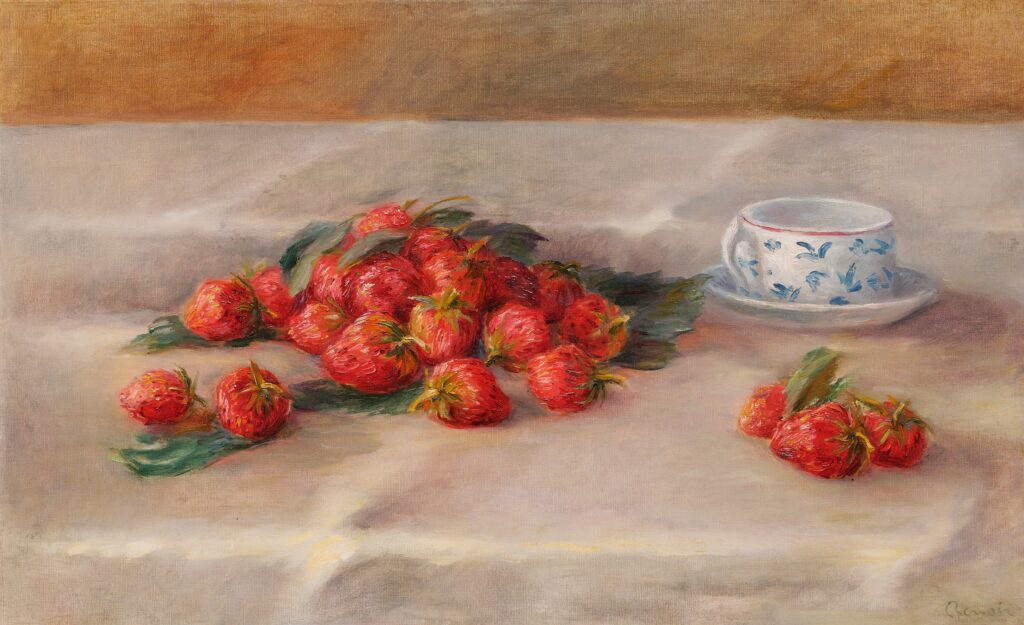
An exceptional work by one of the early leaders of the Impressionist movement, exquisite Renoirs such as this are rarely found in private hands. A consummate example of Renoir’s small sketches, Les Fraises is both elegant and informal, demonstrating Renoir’s skill with even the simplest of subjects. The strawberries are modeled and arranged with an extreme delicacy, their sun-kissed bright colors seeming to glow against the simple white tablecloth and bundle of deep green leaves. Les Fraises was acquired by Paley seventy years ago, in 1952.
André Derain, Bords de Seine à Chatou, circa 1906
Oil on canvas,
Estimate $2,500,000-3,500,000
New York: Modern Art Evening Sale, 14 November
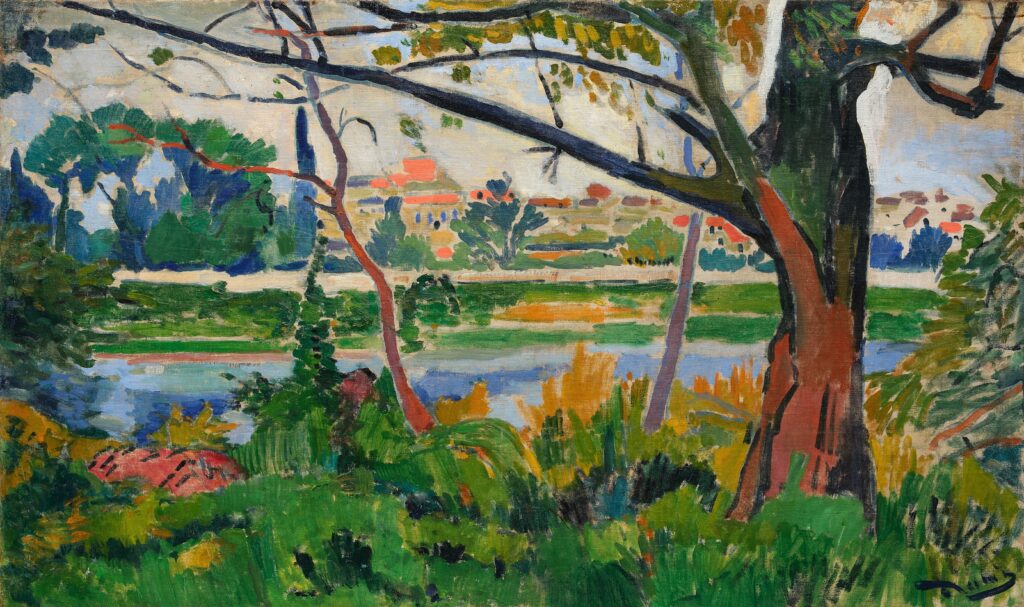
This early landscape by one of the leading figures of the avant-garde depicts Chatou, a landmark destination for the Impressionists, and the burgeoning Fauve movement. Derain himself and another of the great Fauve painters, Maurice de Vlaminck, grew up there, where they shared an atelier in the beginning of the 1900s. Today, most comparable early landscapes by Derain are held in museum collections, and are rarely seen on the market: only three comparable works have been offered at auction in the last five years, all of which were smaller in scale. This exceptional example has been held in Paley’s collection since 1956.
Pierre Bonnard, Nature morte, 1939
Oil on canvas, Estimate $2,500,000-3,500,000
New York: Modern Art Evening Sale, 14 November
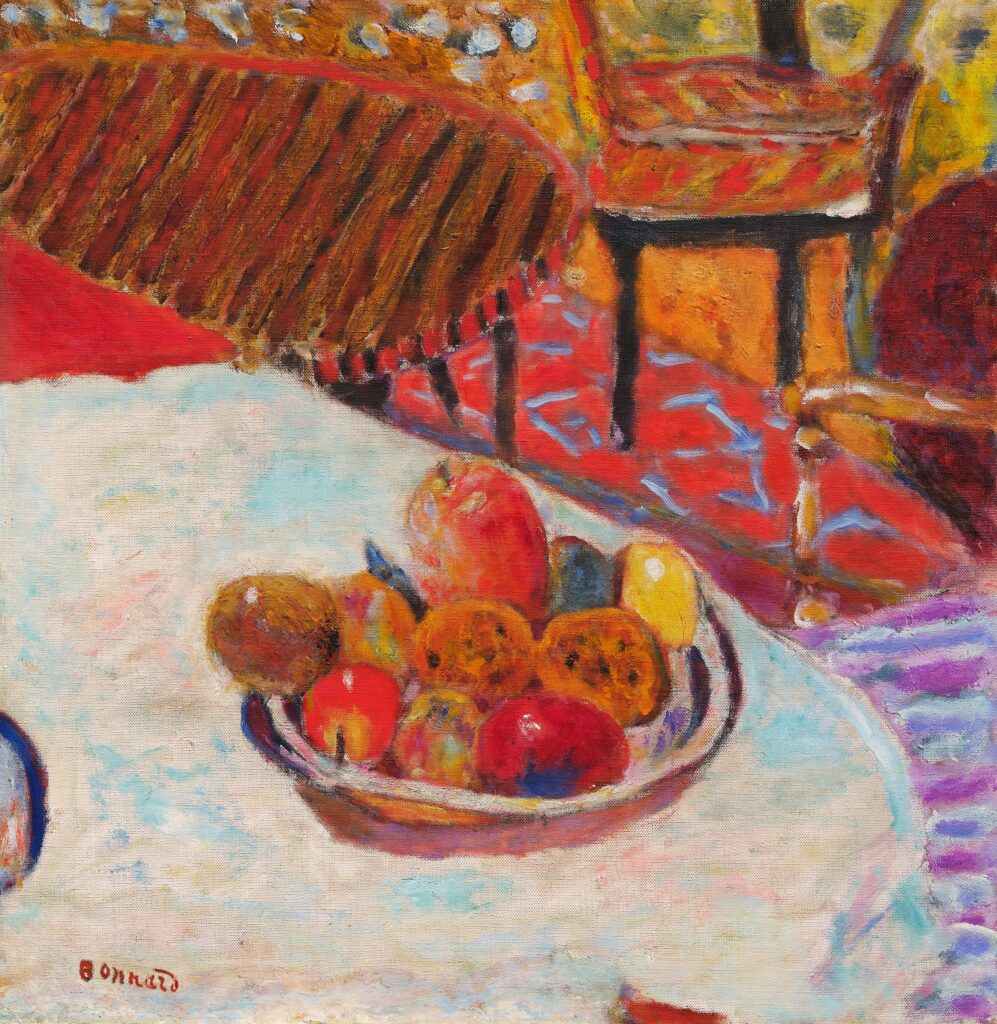
Acquired in 1954, Nature morte is characteristic of the artist’s best work from his time in the south of France, shimmering with bright Mediterranean light and brilliant colors. By the time Bonnard painted this late still life, he had supplanted his earlier scenes of quiet domestic calm with compositional arrangements that filled the entire surface of the canvas with combinations of pattern and color. Dispensing with any grounding vanishing point, the artist pushes every element in his view onto a single plane and uses color to suffuse the painting with a luminescent quality of light. Bonnard’s interest in transforming day-to-day interiors may have been partly indebted to Henri Matisse, an artist whose company he enjoyed throughout their enduring friendship and with whom he often exchanged ideas.
Auguste Rodin, Les Bourgeois de Calais, conceived between 1887 and 1895
Bronze
New York: Modern Art Evening Sale, 14 November
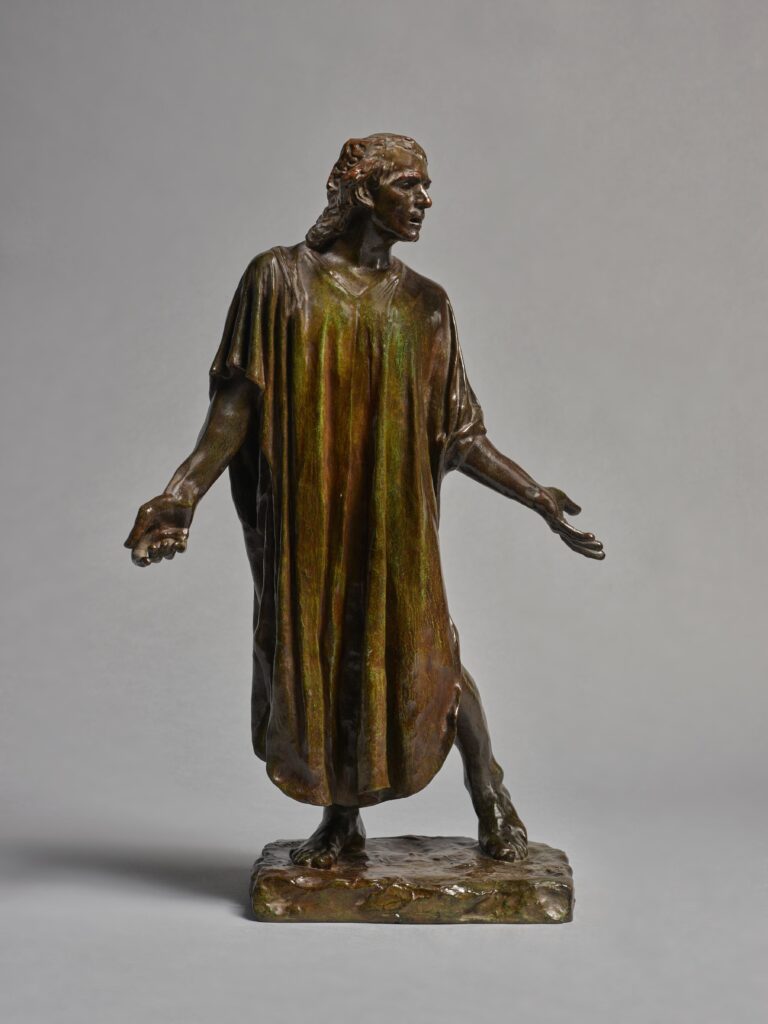
In 1884 Rodin was approached by the mayor of Calais to create a monument to the celebrated burghers of the city, who in 1347 had offered themselves to the King of England, Edward III, in return for the lifting of a year-long siege of the town. Their heroic act and that of the four burghers who accompanied them is commemorated in Rodin’s monumental sculpture Les Bourgeois de Calais, now widely recognized as one of the greatest achievements in modern sculpture. Following the official commission in 1885, Rodin worked tirelessly on developing the characters of the individual figures and, rather than idealizing the men, he sought to explore the physical and psychological tension occasioned by this historic event. He originally executed the figures on a monumental, larger-than-life scale, and the reduced versions followed several years later. These bronzes were passed down to William S. Paley from his father, Samuel Paley.
Joan Miró, Peinture, 1949
Oil on canvas
Estimate $700,000-1,000,000
New York: Modern Art Evening Sale, 14 November
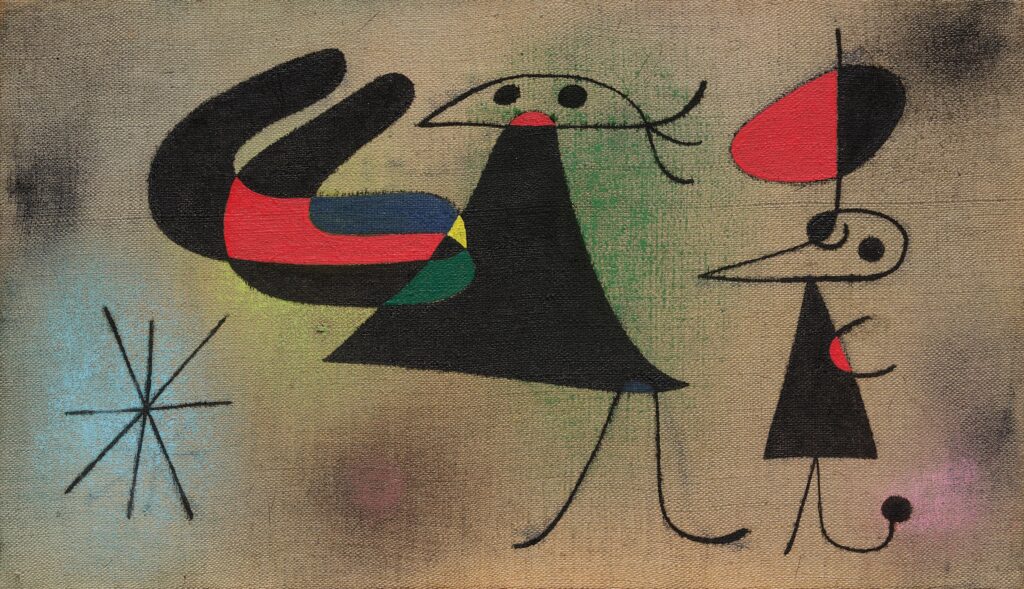
Acquired by Paley in 1950, just one year after it was painted, Peinture – while small in format – retains the poetic and jewel-like qualities of Miró masterpieces, relating closely in form, palette and theme to the most coveted of Miró’s Constellations series. Striking in its modernity, Peinture exemplifies the stylistic qualities that distinguish Miró not only as a master Surrealist, but also as a leading figure of the European avant-garde. The paintings he produced at the this time – at the end of the 1940s and the beginning of the 1950s – are a fascinating response to new trends of abstraction, especially to the American Abstract Expressionists who had so admired his own work, but they also show Miró’s allegiance to his own artistic pursuits.
Henri Rousseau, Vase de fleurs à la branche de lierre, première version, 1901-02
Oil on canvas, Estimate $1,500,000 – $2,000,000
New York: Modern Art Evening Sale, 14 November
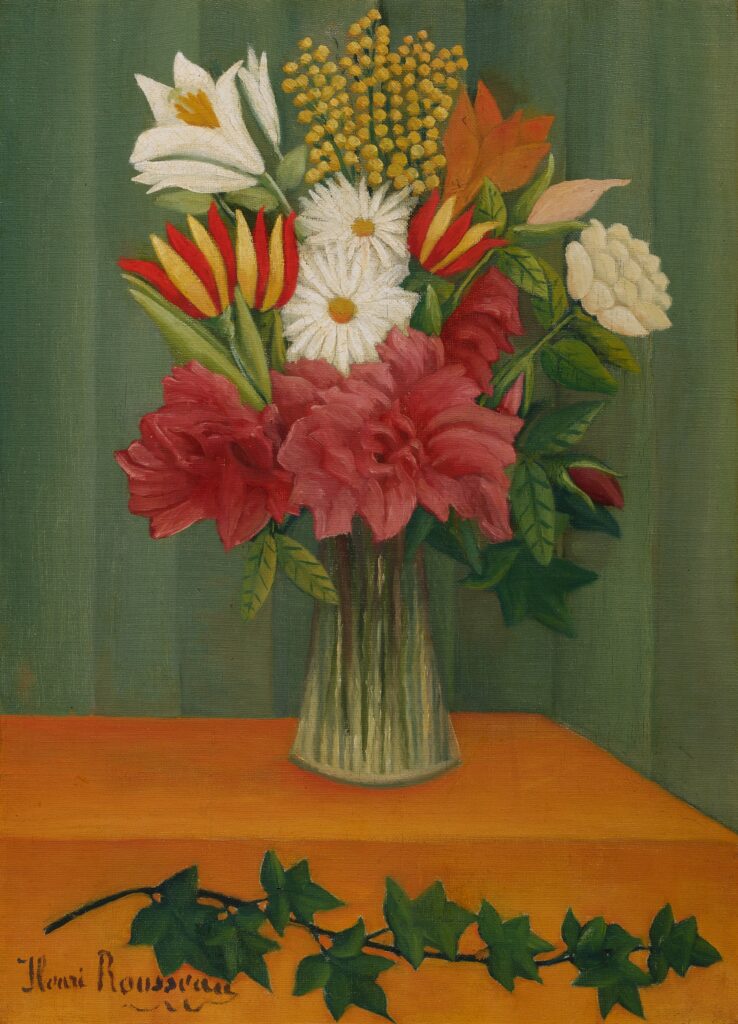
Acquired by Paley in 1937, Rousseau’s Vase de fleurs à la branche de lierre, première version, is emblematic of his boldly idiosyncratic style that placed him at the forefront of the Primitivist movement. Very rare on the market, fewer than a handful of the artist’s flower paintings have ever been offered at auction, with the most recent appearing 15 years ago. With no formal training, Henri Rousseau had taken up painting upon retiring as a minor customs inspector at a suburban toll station, but his exuberant scenes captivated many in the Parisian avant-garde who disparaged industrial society. Among these admirers was Picasso, who happened upon one of Rousseau’s paintings being sold as a canvas to paint over and began planning a banquet in his honor, to which were invited Guillaume Apollinaire, Jean Metzinger, Marie Laurencin, Juan Gris, Gertrude Stein and other luminaries of the modernist beau monde.
William S. Paley and The Museum of Modern Art
“One of his business associates told me, somewhat enviously, that it was well known at CBS that Mr. Paley always answered a call from The Museum of Modern Art, even when other matters required his immediate attention.” – Richard E. Oldenburg, Director of the Musuem of Modern Art (1972-1995)
During five decades of close involvement with The Museum of Modern Art, William S. Paley helped guide the institution that defined the very landscape of modern art in America. His unparalleled contributions to the museum in time, energy and artwork set a lasting precedent for donors and patrons to come.
Paley’s involvement with the institution began in 1937, at age 36, when at the invitation of Nelson Rockefeller he became a trustee of the museum, which had been founded only eight years earlier. He grew in step with the organization, becoming its Vice Chairman from 1959 to 1968, President from 1968 to 1972, Chairman from 1972 to 1985, and Chairman Emeritus from 1985 until his death at age 89 on October 26, 1990, by when MoMA was firmly established as the world’s most influential center for modern art.
As a trustee, Paley assisted in some of MoMA’s most daring and important purchases, including Picasso’s Cubist masterpiece Les Demoiselles d’Avignon which would be shown alongside Guernica and Paley’s own Boy Leading a Horse at the museum’s groundbreaking retrospective of the artist in 1939.
On Paley’s death, 81 works from his collection passed to his Foundation and were placed under the stewardship of MoMA, with the understanding that both parties would have the flexibility and freedom to determine together how these works could best be used to serve the public and the changing needs of the institution.
In 1992, in celebration of Paley’s fifty-year-long service to the museum, MoMA would go on to present all 81 works in the exhibition The William S. Paley Collection which subsequently traveled to six art museums across the country. Select works from the Collection have been on view at MoMA ever since. In 2012-14, MoMA organized the traveling exhibition The William S. Paley Collection: A Taste for Modernism, featuring more than 60 works, to other institutions, including the de Young Museum and Crystal Bridges Museum of American Art.
Given the heightened importance of new media in reaching and engaging audiences, the Foundation and MoMA have decided that the best way to support the museum’s ambitious goals in media and technology, and to make new strategic acquisitions, would be to stage the forthcoming sale, proceeds from which will be used to further the mission of both the Foundation and MoMA.
About William S. Paley and the William S. Paley Foundation
William S. Paley, founder of CBS, established the William S. Paley Foundation in 1936, the year before he joined the Board of Trustees of the still-young Museum of Modern Art at the invitation of Nelson Rockefeller. Organized as a not-for-profit corporation under the laws of the State of New York, the Foundation makes charitable contributions to non-profit organizations from funds received from Mr. Paley, his estate, and earnings on the Foundation’s investments. Principal beneficiaries of the Foundation’s contributions are The Museum of Modern Art, the Paley Museum (which Mr. Paley founded in 1975 as the Museum of Broadcasting), and Paley Park on East 53rd Street, which Mr. Paley established in 1967 for the public to enjoy as a memorial to his father, Samuel Paley.
Sale Calendar
Modern & Contemporary Evening Auction, London, 14 October 2022 (1 work)
Modern Evening Auction, New York, 14 November 2022 (7 works)
Modern Day Auction, New York, 15 November 2022 (13 works)
Contemporary Evening Auction, New York, 16 November 2022 (3 works)
Contemporary Day Auction, New York 17 November 2022 (4 works)
Prints, New York April, 2023 (1 work)
